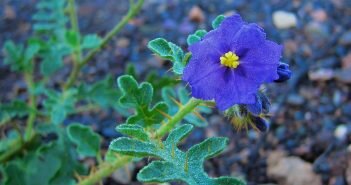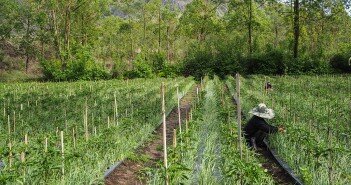Ramial Chipped Wood, also called, RCW is an agroforestry technique, which involves chipping branches less than 7mm thick and incorporate it into the soil. This material is organic, cheap, and readily available and has the potential to restore fertility of our farmlands. It is a relatively new method, which looks at forest floor for inspiration. Some researchers believe it could revolutionize agriculture the way conventional compost techniques cannot.
The term was first coined in the 80’s and according to Professor Gilles Lemieux from the Department of Wood and Forestry Science in Quebec this part of the tree has never been scientifically described. He could not found one mention of branches in the scientific literature. It’s hard to believe that something so available and potentially revolutionary has never attracted anyone’s curiosity, so if you have more information or if you have experimented with Ramial Chipped Wood please share in the comments below or send me an email at [email protected], we’d love to publish other people’s thoughts.
The magic of branches
This technique is inspired by the working of forests and the way they self sustain without any human interaction, producing food for countless animals, birds, fishes and insects. When studying forest floors you learn that before falling off, leaves give 50 to 60% of their energy back to the branches. The branches now contain all the nutrients needed for the buds to grow new branches, which will in turn hold the nutrient to grow new branches again and the tree keeps on handing down its energy to the new generation of branches. It means that trees start their growth again in spring with only what is contained in their youngest branches. When you look at a thicker piece of wood, you don’t find the same concentration of nutrients. “The wood itself serves as a physical support and carrier, and has no role in biological dynamics. It is in the branches that photosynthesis takes place, and glucose molecules are turned into plant tissues.” Says Gilles Lemieux from the Department of Wood and Forestry Science in Quebec.
The process of Making Ramial Chipped wood (RCW)
Harvested from various deciduous species in autumn, branches less than 7cm thick are chipped and the mulch is then spread over the soil, 3 to 5cm thick. RCW must not be composted nor ploughed under but spread in a thin layer and It must be spread fresh on the soil. If left to decompose, it will make a good organic conditioner but his chemical composition and his impact on the soil will be different. You then incorporate the mulch into the 5 cm of topsoil, the whole process last in between 60 to 90 days. This article goes in more details about how to make Ramial chipped wood.
How Ramial Chipped Wood work
In this lapse of time the decomposing branches release high-protein, nutrient rich lignin1 into the soil in a form digestible to fungi, which in turns distribute the other nutrients throughout the ground, in a form plants and animals can absorb. RCW “is not just a soil conditioning process”, says Jacky, “it is potentially revolutionary, because it actually results in the creation of soil. “
RCW contains all the nutrients that are associated to varying degrees with the nutrients necessary to generate and support life. In addition to cellulose, hemicellulose and lignin, ramial wood contains proteins, all the amino acids, nearly all the sugars and starches, countless enzyme systems and hormones, as well as polyphenols, essential oils, terpenes, tannins and more.
The problem is that these nutrients are locked into aromatic rings, which only very few organisms are adapted to digest. Among those few are the protozoa and bacteria, but the most important are the fungi of the Basidiomycetic group. http://en.wikipedia.org/wiki/Basidiomycota
The Benefit of Ramial Chipped Wood
These are the benefits I collect during my readings:
- Increase of more than 50% in organic soil content
- Productivity increases ranging from 30% to 300%, depending on the crop
Reduced water consumption
Major reduction in insects and diseases - Major reduction of weeds
improved resistance to frost and drought. - Crops preserve better and taste better
If you are interested in applying RCW, this article goes into a little more details; he covers things such as species of trees to use, tools, and storage.
If you want to go more technical and you understand complicated words such as hypogeous ecosystem, then this research paper is for you.
Have you experienced or read about Ramial Chipped Wood? Share in the comments below, or give us a shoot at [email protected] we’d love to learn from your experiences.
Sources
- http://www.stellarviolets.org/creating-soil-with-ramial-chipped-wood/
- http://blog.terra-symbiosis.org/le-bois-rameal-fragmente-et-les-champignons/
- http://www.dirtdoctor.com/view_org_research.php?id=69






6 Comments
Judging from the article, if you are going to use wood chips for fertilizer, the best time to put them through a chipper is right after they have lost their leaves. This way the branches have all of the nutrients from the leaves, as the article says. Those nutrients could then be passed to the soil as the wood slowly decomposes.
Yes Jasper, you understood the concept, timing is very important
Thanks for sharing, Marine.
This is actually very interesting–didn’t know the timing matters that much.
I’m definitely going to give this a try.
Glad to have found your site.
Cheers
Oli
Hi Olivier,
Glad you found the article, its an amazing technique for temperate climate especially. Let me know how it goes, if you try it out.
Marine
We are a group of volunteers and opening a brand new scheme in our community.
Your web site provided us with valuable info to work on. You’ve done a formidable job and
our entire neighborhood will likely be thankful to you.
Hi,
Thanks so much for the comment. I would love to help more if I can. Please send me link of your project, I could write an article about it in the blog and promote it also.
Good luck,
Marine